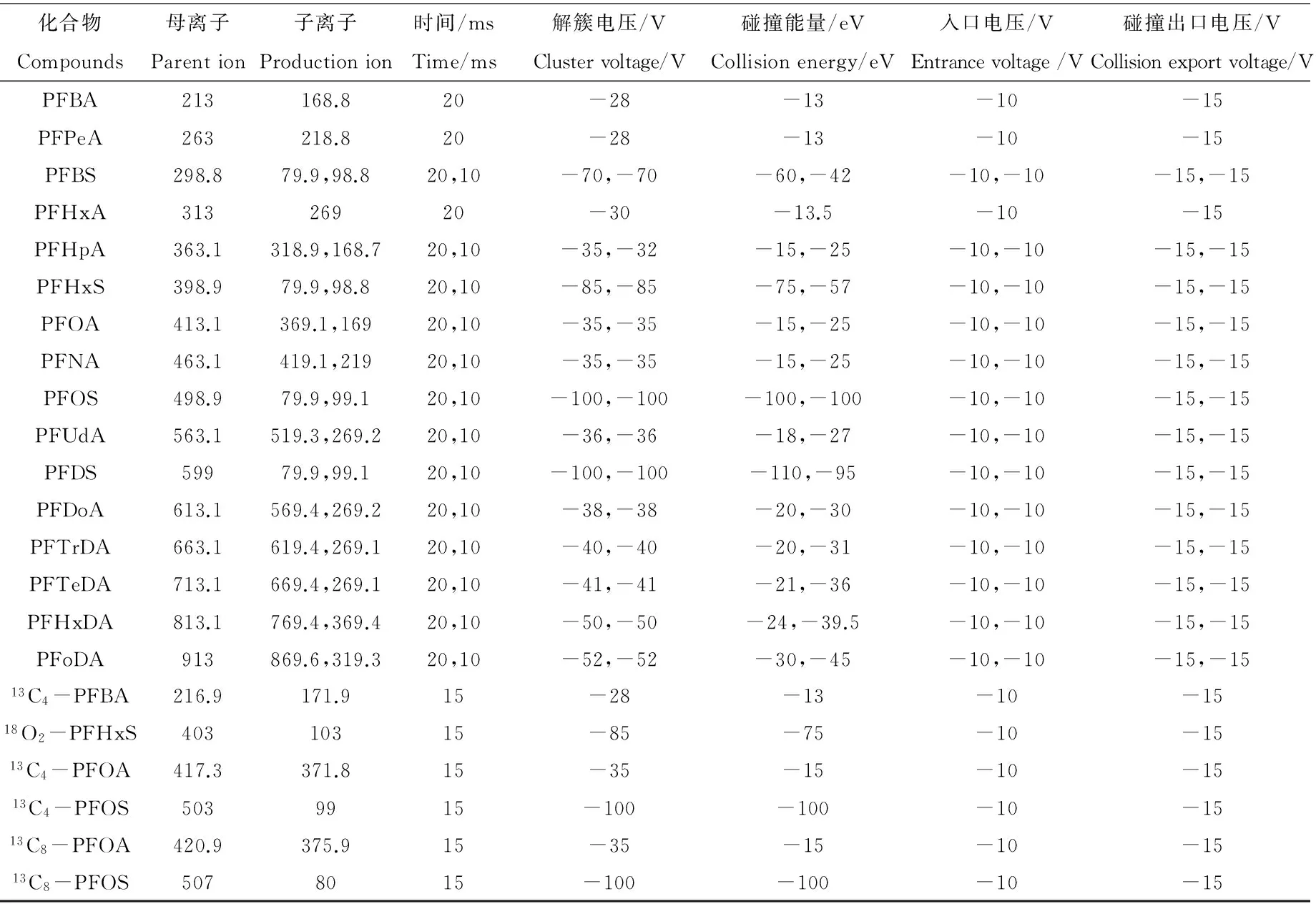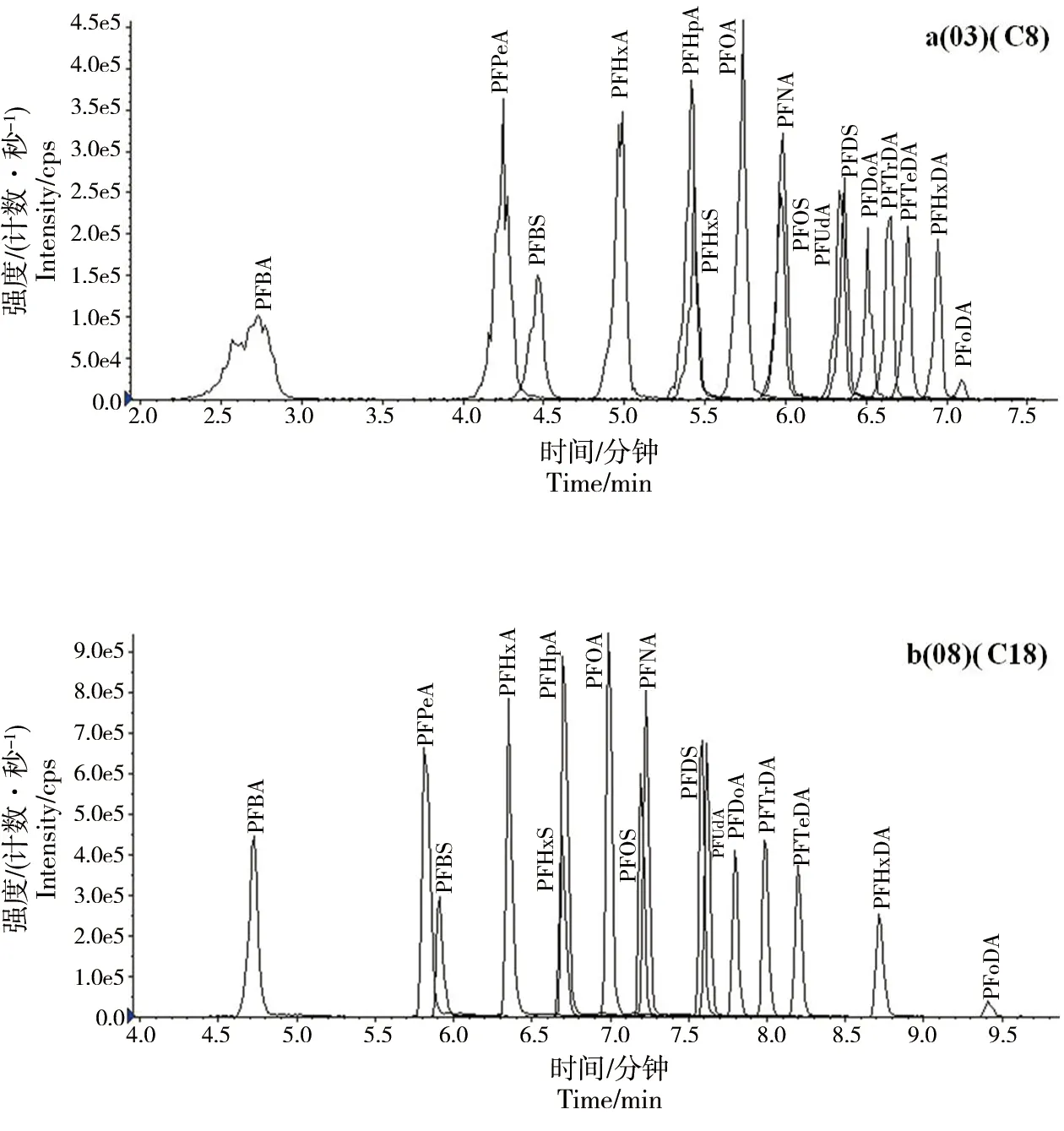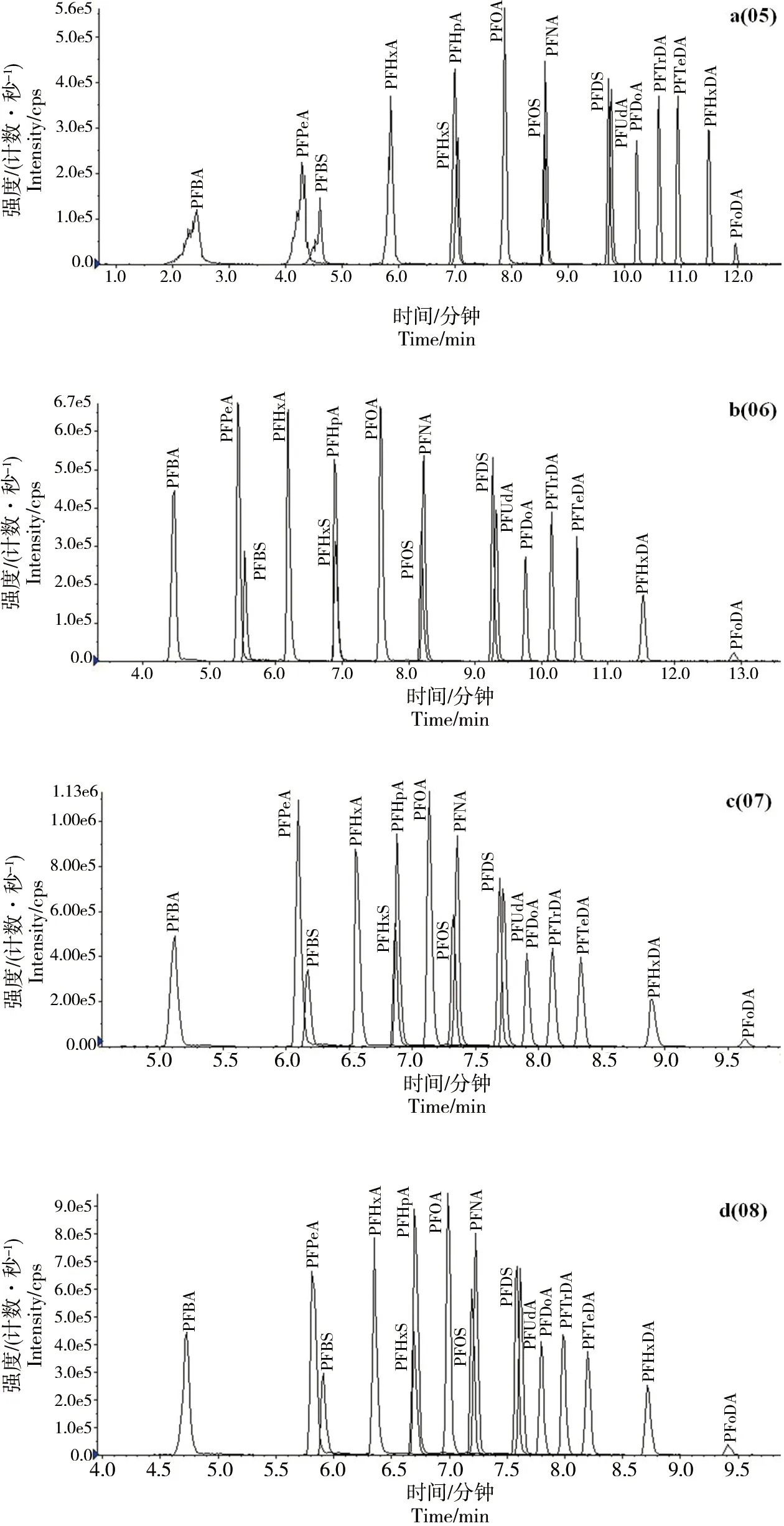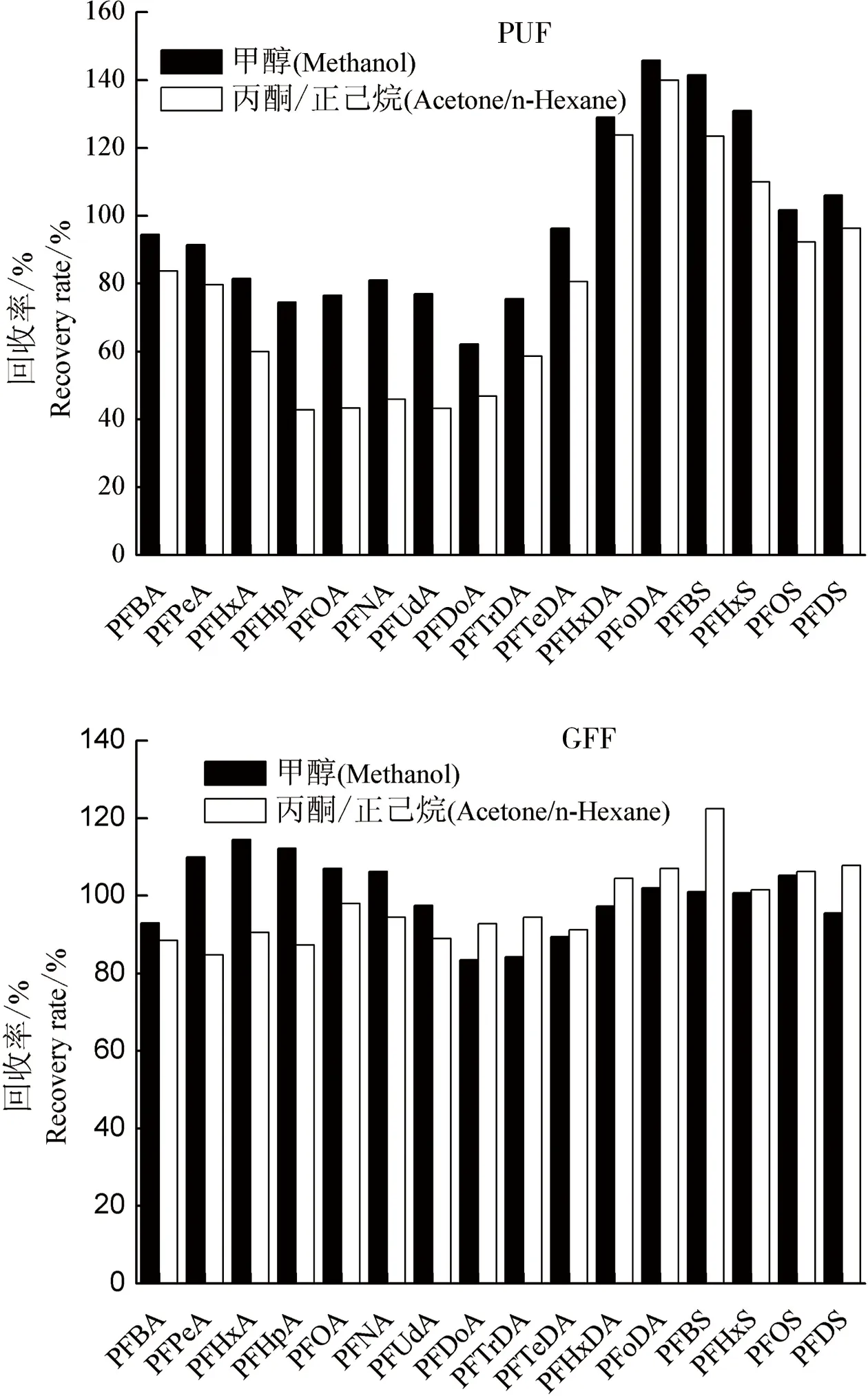快速液相色谱-串联质谱法测定环境空气中的全氟化合物
张俊桦,祝玉杰,陈来国,冯倩华,高博,叶芝祥,贺德春,丁紫荣
1. 环境保护部华南环境科学研究所 城市生态环境研究中心,广州 510655 2. 成都信息工程大学 资源与环境学院,成都 610225 3. 广东工业大学 环境科学与工程学院,广州 510006
快速液相色谱-串联质谱法测定环境空气中的全氟化合物
张俊桦1,3,祝玉杰1,2,陈来国1,,冯倩华1,高博1,叶芝祥2,贺德春1,丁紫荣1
1. 环境保护部华南环境科学研究所 城市生态环境研究中心,广州 510655 2. 成都信息工程大学 资源与环境学院,成都 610225 3. 广东工业大学 环境科学与工程学院,广州 510006
不同研究报道的空气中离子型全氟化合物(PFCs)的分析方法各不相同,本文的目的在于对比和优化不同分析条件。通过对比不同流动相(甲醇和乙腈)、不同色谱柱(C8和C18)、不同梯度洗脱条件下目标化合物的分离效果,确定了以甲醇为流动相、C18色谱柱为分离柱和最佳梯度淋洗液分离的仪器分析条件。比较了甲醇和正已烷/丙酮混合溶剂萃取气相(PUF)和颗粒相(GFF)样品的效果,确定以甲醇为萃取溶剂。建立了空气中PFCs的LC-MS/MS优化分析方法,方法线性范围在0.1~50 ng·mL-1之间,PUF与GFF样品方法检出限分别为0.02~0.35 pg·m-3和0.02~0.26 pg·m-3。同时将方法用于大气实际样品分析。
全氟化合物;空气;液相色谱-串联质谱;优化
Received 24 December 2015 accepted 26 January 2016
不同于疏水亲脂的“传统”持久性有机污染物(POPs)(如PCBs、OCPs等),全氟化合物(PFCs)具有高表面活性、高热稳定性、高化学惰性和憎水憎油性,使其分析方法、环境迁移转化过程与归趋都不同于上述“传统”POPs[1]。近十年来,才对关于PFCs的环境过程、归趋和毒性效应开展较深入的研究。相对于其他介质(水、沉积物、生物、人血等)[2-8]或毒性效应[9-14]研究,大气中PFCs的研究相对较少[15-18],国内其研究还处于起步阶段。
就大气离子型PFCs分析方法而言,不同研究报道的分析条件有较大差异。如对于仪器分析条件,不同研究报道使用不同流动相[19-20]、不同色谱柱[19, 21]、不同梯度洗脱条件[22-23]和质谱条件[20, 23]。对于样品前处理,不同的研究报道使用不同抽提溶剂[20-21, 24-25]、不同净化流程等[21, 24]。有必要对上述不同的分析方法条件进行对比和优化,确定较佳的大气离子型PFCs分析方法。
本文对比和优化了离子型PFCs的仪器分析条件、大气样品的前处理方法,建立了大气样品中离子型PFCs的优化分析方法,并对实际环境空气样品进行了初步分析。
1 实验部分(Experimental section)
1.1 材料与试剂
全氟丁酸(PFBA)、全氟戊酸(PFPeA)、全氟己酸(PFHxA)、全氟庚酸(PFHpA)、全氟辛酸(PFOA)、全氟壬酸(PFNA)、全氟十一烷酸(PFUdA)、全氟十二烷酸(PFDoA)、全氟十三酸(PFTrDA)、全氟代十四酸(PFTeDA)、全氟十六烷酸(PFHxDA)、全氟十八酸(PFoDA)、全氟丁烷磺酸钾盐(PFBS)、全氟己烷磺酸钠盐(PFHxS)、全氟辛烷磺酸钠盐(PFOS)、全氟癸烷磺酸钠盐(PFDS),同位素标记物质MPFBA(13C4-PFBA)、MPFHxS(18O2-PFHxS)、MPFOA(13C4-PFOA)、MPFOS(13C4-PFOS)、M8PFOA(13C8-PFOA)、M8PFOS(13C8-PFOS),均购自美国Wellington公司,纯度均>98%。农残级甲醇和乙腈(Sigma-Aldrich,美国),正己烷(Honeywell,美国)和丙酮(J TBaker,美国)均为色谱纯。乙酸铵购自广州化学试剂厂,分析纯。
聚氨酯海绵(PUF)及滤纸预抽提:PUF和滤纸依次用甲醇、二氯甲烷和正己烷分别抽提48 h、48 h和24 h,真空干燥,密封保存。
玻璃纤维滤膜(GFF)去活化处理:GFF先在450 ℃马弗炉烘烤4 h,后用六甲基二硅胺烷(HMDS)作为硅烷化试剂去活化处理。
C8柱:Luna 3μ C8(2),50 mm×2.0 mm×3 μm,Phenomenex,美国;C18柱:Atlantis C18Column,100 Å,150 mm×2.1 mm×3 μm,Waters,美国。
1.2 仪器设备
Agilent1260快速液相色谱仪(Agilent,美国),AB 4000Qtrap串联质谱-线性离子阱质谱仪(ABSCIX,美国),Milipore超纯水系统,Eppendorf移液器(100~1 000 μL,100~5 000 μL),总悬浮颗粒物(TSP)采样器(天虹,中国)。
1.3 分析条件优化
1.3.1 仪器分析条件优化
(1)色谱条件优化
①流动相的选择
乙腈、甲醇和四氢呋喃常用作反相色谱柱流动相。四氢呋喃易分解形成过氧化物,加水虽能抑制其分解,但其在色谱中的平衡时间比乙腈和甲醇长,并伴有异味,所以一般选用乙腈或甲醇为有机相。以10 μg·L-1的PFCs混合标准液为测试对象,以C8柱为色谱分离柱,对比了乙腈和甲醇作为流动相对PFCs的分离效果(表1)。
②色谱柱的选择
合适色谱柱可以获得良好的分离效果,减少干扰,提高仪器分析的检测限。不同的研究报道使用不同的色谱柱分离PFCs[20,26-27],本文对比了C8柱和C18柱2种色谱柱对PFCs的分离效果(表1)。
③梯度洗脱条件
以C18柱为分离柱、乙酸铵(5 mmol·L-1)和甲醇为流动相,对比了不同梯度洗脱条件对PFCs的分离效果(表1)。

表1 液相色谱梯度淋洗条件

表2 质谱检测条件
(2) 质谱条件
离子源:电喷雾(ESI),多反应监测模式(MRM);锥孔电压:-4 500 V;气帘气(CUR):0.2 MPa;碰撞气(CAD):Medium;雾化气(GS2):0.55 MPa;离子喷雾电压(IS):-4 500 V;离子源温度(TEM):550 ℃;其他条件见表2。
1.3.2 样品前处理方法优化
对于PFCs前体物,常用的提取溶剂为二氯甲烷[20-21, 24-25]、乙酸乙酯[18, 28-29]、石油醚/丙酮混合溶剂[20, 25, 33]。而对于PFAAs,常用溶剂有甲醇[20-21, 32, 34-35]、甲醇/丙酮[23]和丙酮/正己烷混合溶剂[34]等。本文分别采用溶剂加标和基质加标实验考察了甲醇和丙酮/正已烷(1:1,V:V) 2种溶剂的萃取效率,在溶剂和基质中加入标准物质使定容后的加标量为20 ng·mL-1,同时做2个平行样。
1.4 标准曲线的建立
配制系列标准溶液,其浓度分别为0.10、0.25、0.50、1.0、2.5、5.0、10、20和50 ng·mL-1,其中回收率指示物为13C4-PFBA、13C4-PFOA、18O2-PFHxS和13C4-PFOS,内标物为13C8-PFOA和13C8-PFOS。各目标物的标准曲线方程的R2值都在0.99以上。
1.5 仪器检出限与线性范围
将标准液稀释后进行仪器分析,当目标物的信噪比(S/N)≥3且偏差小于30%时对应的最小浓度即为仪器检出限(IDL)。本研究中,仪器进样量为10 μL,各目标物的IDL为0.01~0.15 ng·mL-1。当S/N≥10时,对应化合物最小浓度即为仪器定量限,定量限为0.04~0.55 ng·mL-1。本研究与其他研究报道的仪器检出限和定量限相近(0.01~0.27 ng·mL-1)[23]。
1.6 质量保证与质量控制
实验中所使用的有机溶剂全部为色谱纯或农残级。实验过程中尽量不使用含氟塑料制品,玻璃器皿使用前过洗液并冲洗,450 ℃马弗炉烘烤。所有玻璃器皿使用前再用少量二氯甲烷、正己烷清洗3次或超声后使用。
空白试验包括溶剂空白、基质空白和现场空白,在上述空白样品中PFUdA、PFDoA、PFTrDA、PFTeDA、PFHxDA和PFoDA全部为未检出,其他PFCs则检出较低含量。实测结果扣除现场空白。
PUF和GFF空白基质样品加入混合标样10 ng (定容至500 μL为20 ng·mL-1),回收率范围分别为74%~129%和83.5%~114.5%,平行样标准偏差(SD)均为1%~9%。PUF和GFF样品中指示物13C4-PFBA、13C4-PFOA、18O2-PFHxS和13C4-PFOS回收率分别为86.0%~116%和98.2%~117%。按照文献报道方法计算方法检出限(MDL)[36],PUF与GFF样品目标物MDL分别为0.02~0.35 pg·m-3和0.02~0.26 pg·m-3,与Ahrens等[20]报道的结果相当(0.001~1.866 pg·m-3和0.001~1.653 pg·m-3)。
1.7 实际大气样品的采集与方法验证
利用总悬浮颗粒物(TSP)采样器在广州市天河区采集大气样品,采样流量为300 L·min-1,时间为2015-03-23至2015-03-25,同时采集PUF和GFF样品。每天采集1个样品,时长约24 h。利用上述实验确定的优化分析方法对样品进行分析。
2 结果与讨论 (Results and discussion)
2.1 仪器分析条件优化
(1) 流动相的选择
乙腈与甲醇相比,其粘度小,吸光度较低,噪声较小,柱内承受压力较低。在反相色谱条件中,乙腈洗脱能力虽高于甲醇,但两者在洗脱的选择性上有差异,非质子极性溶剂乙腈易对溶质分子作用,产生溶剂化效应,易产生拖尾现象,而质子性溶剂甲醇则有抑制拖尾作用。

图1 甲醇和乙腈对PFCs分离效果对比Fig. 1 Comparison of separating effect of PFCs with methanol and acetonitrile
对比乙腈和甲醇对PFCs混标的分离效果(图1),除PFBA外,PFCs混标在二者中均能实现有效分离。从峰型上看,乙腈可在C8反相色谱短柱中改善PFBA峰型,增强色谱响应,峰宽较窄,峰形较好(图1(b)和图1(c))。虽然乙腈作为流动相传质阻抗小,有利于柱效提高,但甲醇作为样品萃取溶剂,选其作为流动相可避免干扰,并且价格低廉,方便易得,因此选择甲醇作为流动相。
(2)色谱柱的选择
C8与C18柱均为反相色谱柱,适用于分析弱极性物质,C8柱适合分析极性稍强的物质,而C18柱则适合分析极性稍弱的物质,如PFCAs(C12~C18)。一般能用C8柱分析的物质,也能用C18柱分析。由图2可见,较长链的PFCAs和PFSAs在C8与C18柱上响应差别不大,而对于较短链长的PFBA和PFPeA,C18长柱响应更强,峰型更好。因此,选用C18柱分析PFCs。

图2 不同色谱柱对PFCs分离效果对比Fig. 2 Comparison of separating effect of PFCs with different chromatographic columns
(3)梯度洗脱条件优化
当有机相比例较低且流速较慢时,低碳的PFBA、PFPeA和PFBS的峰型较差(图3(a))。在0~8 min,提高有机相比例,保持梯度洗脱条件基本不变,可使PFBA、PFPeA和PFBS前延现象消失,峰型改善(图3(b))。在0~6 min,提高有机相比例并增加其升高速率,在保持高效分离的前提下可使分析时间从13 min缩至9.5 min (图3(c)、图3(d)),提高分析样品的效率。因此最终选用表1编号08所对应的流动相洗脱条件。

图3 梯度洗脱条件对PFCs分离效果对比Fig. 3 Comparison of separating effect of PFCs with gradient elution
2.4 前处理方法优化
(1) 不同溶剂提取效果对比
以基质加标模拟实际样品。对于GFF基质加标实验,甲醇和丙酮/正己烷萃取效率均较高(回收率分别为83.5%~114.5%和84.8%~122.5%),且实验平行性均较好(SD<10%)。对于PUF,甲醇对PFCAs及PFSAs提取效果(80%~129.5%)明显好于丙酮/正己烷(38%~132.5%),而PFDoA回收率相对较低(61%和63.5%),长链C16、C18的PFCAs的回收率过高(147%)(图4),可能受基质效应影响。无论提取溶剂为甲醇还是丙酮/正己烷,SD均小于10%。对比提取效果,本方法选用甲醇作为萃取溶剂。

图4 PUF(GFF)基质加标溶剂回收率对比Fig. 4 Comparison of recovery rate of methanol and acetone/n-hexane in PUF and GFF
(2) 样品的抽提与净化方法
气相PUF/XAD样品通常使用经典的索氏抽提[20-21, 25],也有用加速溶剂萃取(ASE)[23, 37],其中索氏抽提样品回收率为83%~104%,SD约为9%[25],而ASE样品回收率最高只有74%,SD为0.2%~20%[37]。颗粒相滤膜样品则多采用超声萃取,其可以在较低的温度下、较短时间内获得较高的提取效率(回收率为61%~120%,SD为9%~21%)[20],也有研究使用索氏抽提[25, 27-28, 30],回收率为99%~155%,SD为1%~14%[25]。GFF样品抽提液浓缩后通常需进行离心操作[21, 24],一些研究则在进样前增加了除水和净化步骤[24],也有研究直接加标进样检测,基线杂峰较少,效果较好[15, 31, 35]。在对实际样品的前处理过程中发现PUF和GFF样品经旋蒸以及氮吹后均有絮状物析出。试验分别对氮吹后样品进行滤纸过滤、过无水硫酸钠柱和有机相针式过滤,前两种方法回收率低且容易引入污染,故使用有机相针式过滤。综合考虑不同提取方法对PUF和GFF样品的回收率与偏差以及处理过程中有絮状物析出、易受污染等问题,本方法采用索氏抽提PUF样品和超声萃取GFF样品,旋蒸浓缩至体积较少时离心(6 500 r·min),取上清液移至鸡心瓶,再旋蒸和氮吹,定容后加入内标物质,如仍有不溶物,则用有机相(聚丙烯外壳,增强型尼龙微孔滤膜,13 mm)针式滤器过滤,待澄清溶液,直接进样分析。
2.5 实际样品测定
采样期间广州大气中(气相+颗粒相)总PFCs的含量分别为9.12~15.93 pg·m-3和20.04~26.26 pg·m-3,两相中PFOA和PFBA含量都较高(表3)。Barber等[30]报道爱尔兰Mace Head大气颗粒相中PFCAs和PFSAs分别为3.1~35.91 pg·m-3和0.05~2.91 pg·m-3。杨运云等[23]报道2007年广州大气中(气相+颗粒相)PFCs含量分别为5.2~37.4 pg·m-3和11.3~74.3 pg·m-3。与上述报道相比,PFCs含量相近。本研究发现大气中PFCs主要集中在短链(C4~C9) PFCAs中,约占总含量的92%~97%,由于其分子量较小,化学稳定性强,易随大气长距离迁移。

表3 广州大气中PFCs的含量水平
注: nd表示未检出。
Note: nd means not detected.
综上可知:
(1) 为分析大气样品中的PFCs,对仪器分析条件和样品前处理进行了对比优化。通过对比,选定C18柱为分析柱,甲醇为有机相,并确定了测试条件下的最佳色谱淋洗条件,确定样品萃取溶剂为甲醇,PUF样品索氏抽提,GFF滤膜样品超声萃取,建立了大气样品中离子型PFCs的LC-MS/MS优化分析方法。
(2) 利用建立的方法对广州市大气样品中PFCs进行了初步分析,表明广州大气中PFCs主要集中在短链(C4~C9) PFCAs中,约占总含量的92%~97%,PFOA含量较高,而PFOS含量较低。
[1] 章涛, 王翠苹, 孙红文. 环境中全氟取代化合物的研究进展[J]. 安全与环境学报, 2008, 8(3): 22-28
Zhang T, Wang C P, Sun H W. Research progress of perfluorochemicals in the environment [J]. Journal of Safety and Environment, 2008, 8(3): 22-28 (in Chinese)
[2] Powley C R, George S W, Russell M H, et al. Polyfluorinated chemicals in a spatially and temporally integrated food web in the Western Arctic [J]. Chemosphere, 2008, 70(4): 664-672
[3] Young C J, Furdui V I, Franklin J, et al. Perfluorinated acids in arctic snow: New evidence for atmospheric formation [J]. Environmental Science and Technology, 2007, 41(10): 3455-3461
[4] Wang T, Khim J S, Chen C, et al. Perfluorinated compounds in surface waters from Northern China: Comparison to level of industrialization [J]. Environment International, 2012, 42: 37-46
[5] Takagi S, Adachi F, Miyano K, et al. Perfluorooctanesulfonate and perfluorooctanoate in raw and treated tap water from Osaka, Japan [J]. Chemosphere, 2008, 72(10): 1409-1412
[6] 金一和, 刘晓, 秦红梅, 等. 我国部分地区自来水和不同水体中的PFOS污染[J]. 中国环境科学, 2004, 24(2): 166-169
Jing Y H, Liu X, Qin H M, et al. The status quo of perfluorooctane sulfonate (PFOS) pollution in tap water and different waters in partial areas of China [J]. China Environmental Science, 2004, 24(2): 166-169 (in Chinese)
[7] 刘薇, 金一和, 全燮, 等. 沈阳市降雪中PFOS和PFOA污染现状调查[J]. 环境科学, 2007, 28(9): 2068-2073
Liu W, Jing Y H, Quan X, et al. Investigation of PFOS and PFOA pollution in snow in Shenyang, China [J]. Environmental Science, 2007, 28(9): 2068-2073 (in Chinese)
[8] Zhang T, Wu Q, Sun H W, et al. Perfluorinated compounds in whole blood samples from infants, children, and adults in China [J]. Environmental Science and Technology, 2010, 44(11): 4341-4347
[9] So M K, Yamashita N, Taniyasu S, et al. Health risks in infants associated with exposure to perfluorinated compounds in human breast milk from Zhoushan, China [J]. Environmental Science and Technology, 2006, 40(9): 2924-2929
[10] 张轩, 张偲, 王光鹏, 等. 全氟辛烷磺酸盐(PFOS) 对土壤跳虫的生态毒性[J]. 生态毒理学报, 2012, 7(5): 525-529
Zhang X, Zhang C, Wang G P, et al. Ecotoxicity of perfluorooctane sulfonate (PFOS) to springtails in soils [J]. Asian Journal of Ecotoxicology, 2012, 7(5): 525-529 (in Chinese)
[11] 夏继刚, 牛翠娟, 孙麓垠. PFOS对斑马鱼胚胎及仔鱼的生态毒理效应[J]. 生态学报, 2013, 33(23): 7408-7416
Xia J G, Niu C J, Sun L Y. Ecotoxicological effects of exposure to PFOS on embryo and larva of zebrafish Danio rerio [J]. Acta Ecologica Sinica, 2013, 33(23): 7408-7416 (in Chinese)
[12] Zhang H, Shi Z, Liu Y, et al. Lipid homeostasis and oxidative stress in the liver of male rats exposed to perfluorododecanoicacid [J]. Toxicology and Applied Pharmacology, 2008, 227(1): 16-25
[13] Wei Y, Chan L L, Wang D, et al. Proteomic analysis of hepatic protein profiles in rare minnow (Gobiocyp risrarus) exposed to perfluorooctanoic acid [J]. Journal of Proteome Research, 2008, 7(4): 1729-1739
[14] Yang Q, Abedi-Valugerdi M, Xie Y, et al. Potent suppression of the adaptive immune response in mice upon dietary exposure to the potent peroxisome proliferator, perfluorooctanoic acid [J]. International Immunopharmacology, 2002, 2(2): 389-397
[15] Shoeib M, Harner T, Ikonomou M, et al. Indoor and outdoor air concentrations and phase partitioning of perfluoroalkyl sulfonamides and polybrominateddiphenyl ethers [J]. Environmental Science and Technology, 2004, 38(5): 1313-1320
[16] Stock N L, Lau F K, Ellis D A, et al. Polyfluorinatedtelomer alcohols and sulfonamides in the North American troposphere [J]. Environmental Science and Technology, 2004, 38(4): 991-996
[17] Jahnke A, Ahrens L, Ebinghaus R, et al. Urban versus remote air concentrations of fluorotelomer alcohols and other polyfluorinated alkyl substances in Germany [J]. Environmental Science and Technology, 2007, 41(3): 745-752
[18] Li J, Del Vento S, Schuster J, et al. Perfluorinated compounds in the Asian atmosphere [J]. Environmental Science and Technology, 2011, 45(17): 7241-7248
[19] Jogsten I E, Nadal M, van Bavel B, et al. Per-and polyfluorinated compounds (PFCs) in house dust and indoor air in Catalonia, Spain: Implications for human exposure [J]. Environment International, 2012, 39(1): 172-180
[20] Ahrens L, Shoeib M, Harner T, et al. Comparison of annular diffusion denuder and high volume air samplers for measuring per-and polyfluoroalkyl substances in the atmosphere [J]. Analytical Chemistry, 2011, 83(24): 9622-9628
[21] Ahrens L, Shoeib M, Del Vento S, et al. Polyfluoroalkyl compounds in the Canadian Arctic atmosphere [J]. Environmental Chemistry, 2011, 8(4): 399-406
[22] Jahnke A, Ahrens L, Ebinghaus R, et al. An improved method for the analysis of volatile polyfluorinated alkyl substances in environmental air samples [J]. Analytical and Bioanalytical Chemistry, 2007, 387(3): 965-975
[23] 杨运云, 邓洁薇, 罗辉泰, 等. 加速溶剂萃取-高效液相色谱-串联质谱法测定空气中的全氟化合物[J]. 分析化学, 2010, 38(11): 1583-1587
Yang Y Y, Deng J W, Luo H T, et al. Determination of perfluorinated compounds in ambient air by accelerated solvent extraction combined with high performance liquid chromatography-tandem mass spectrometry[J]. Chinese Journal of Analytical Chemistry, 2010, 38(11): 1583-1587 (in Chinese)
[24] Cai M, Xie Z, Moller A, et al. Polyfluorinated compounds in the atmosphere along a cruise pathway from the Japan Sea to the Arctic Ocean [J]. Chemosphere, 2012, 87(9): 989-997
[25] Shoeib M, Harner T, Vlahos P. Perfluorinated chemicals in the Arctic atmosphere [J]. Environmental Science and Technology, 2006, 40(24): 7577-7583
[26] 吕刚. 药品包装材料中全氟辛烷磺酸类物质检测与安全评价技术[D]. 天津: 天津大学, 2009
Lv G. Study on determination and safety assessment of perfluorooctane sulfonate (PFOS) in drug packaging materials [D]. Tianjin: Tianjin University, 2009 (in Chinese)
[27] 郝双利. 全氟羧酸的富集, 衍生化及GC-MS分析[D]. 西安: 陕西师范大学, 2013
Hao S L. Enrichment, derivatization and GC-MS analysis of perfluorocarboxylic acid [D]. Xi’an: Shaanxi Normal University, 2013 (in Chinese)
[28] Martin J W, Muir D C G, Moody C A, et al. Collection of airborne fluorinated organics and analysis by gas chromatography/chemical ionization mass spectrometry [J]. Analytical Chemistry, 2002, 74(3): 584-590
[29] Dreyer A, Temme C, Sturm R, et al. Optimized method avoiding solvent-induced response enhancement in the analysis of volatile and semi-volatile polyfluorinated alkylated compounds using gas chromatography-mass spectrometry [J]. Journal of Chromatography A, 2008, 1178(1): 199-205
[30] Barber J. L, Berger U, Chaemfa C, et al. Analysis of per- and polyfluorinated alkyl substances in air samples from Northwest Europe [J]. Journal of Environmental Monitoring, 2007, 9(6): 530-541
[31] Jahnke A, Berger U, Ebinghaus R, et al. Latitudinal gradient of airborne polyfluorinated alkyl substances in the marine atmosphere between Germany and South Africa (53° N-33° S) [J]. Environmental Science and Technology, 2007, 41(9): 3055-3061
[32] Jahnke A, Huber S, Temme C, et al. Development and application of a simplified sampling method for volatile polyfluorinated alkyl substances in indoor and environmental air [J]. Journal of Chromatography A, 2007, 1164(1-2): 1-9
[33] Shoeib M, Vlahos P, Harner T, et al. Survey of polyfluorinated chemicals (PFCs) in the atmosphere over the northeast Atlantic Ocean [J]. Atmospheric Environment, 2010, 44(24): 2887-2893
[34] Boulanger B, Peck A M, Schnoor J L, et al. Mass budget of perfluorooctane surfactants in Lake Ontario [J].Environmental Science and Technology, 2005, 39(1): 74-79
[35] Dreyer A, Ebinghaus R. Polyfluorinated compounds in ambient air from ship-and land-based measurements in northern Germany [J]. Atmospheric Environment, 2009, 43(8): 1527-1535
[36] 环境保护部. 环境监测分析方法标准制修订技术导则(HJ 168-2010)[S]. 北京: 中国标准出版社, 2010
Ministry of Environmental Protection. Environmental monitoring-technical guideline on drawing and revising analytical method standards (HJ 168-2010) [S]. Beijing: Standards Press of China, 2010 (in Chinese)
[37] Piekarz A M, Primbs T, Field J A, et al. Semivolatile fluorinated organic compounds in Asian and western US air masses [J]. Environmental Science and Technology, 2007, 41(24): 8248-8255
◆
Determination of Perfluorinated Compounds in Ambient Air by Rapid Liquid Chromatography - Tandem Mass Spectrometry
Zhang Junhua1,3, Zhu Yujie1,2, Chen Laiguo1,*, Feng Qianhua1, Gao Bo1, Ye Zhixiang2, He Dechun2, Ding Zirong1
1. South China Institute of Environmental Sciences, Guangzhou 510655, China 2. Chengdu University of Information Technology, Chengdu 610225, China 3. Guangdong University of Technology, Guangzhou 510006, China
Various methods have been used to analyze perfluorinated compounds (PFCs) in atmospheric samples. The analytical conditions such as mobile phases of methanol and acetonitrile, chromatographic columns of C8 and C18, and different gradient elution methods were tested in the present work. The results suggested that best separation efficiency could be obtained when methanol was used as mobile phase on C18 chromatographic column with optimized gradient elution method. Methanol was selected as the extraction solvent, since it was more efficient to extract PFCs from both gas phase (polyurethane foam) and particle phase (glass fiber filter) samples than n-hexane/acetone mixture. An optimized method for determination of PFCs in ambient air on LC-MS/MS was established in this study, with a linearity range of 0.1 to 50 ng·mL-1. The method detection limit ranged from 0.02 to 0.35 pg·m-3for PUF samples and from 0.02 to 0.26 pg·m-3for GFF samples, respectively. This method was also applied to analyze PFCs in field atmospheric samples.
perfluorinate compounds; air; LC-MS/MS; optimizing
10.7524/AJE.1673-5897.20151224001
国家自然科学基金面上项目 (41273107,41573123)
张俊桦(1992-),男,硕士研究生,研究方向为大气中污染物的分析方法与迁移转化,E-mail: 442054609@qq.com
*通讯作者(Corresponding author), E-mail: chenlaiguo@scies.org
2015-12-24 录用日期:2016-01-26
1673-5897(2016)2-658-08
X171.5
A
简介:陈来国(1975-),男,博士,研究员,主要研究方向典型环境污染物的分析方法、迁移转化过程与暴露风险,发表学术论文70余篇。
张俊桦, 祝玉杰, 陈来国, 等. 快速液相色谱-串联质谱法测定环境空气中的全氟化合物[J]. 生态毒理学报,2016, 11(2): 658-665
Zhang J H, Zhu Y J, Chen L G, et al. Determination of perfluorinated compounds in ambient air by rapid liquid chromatography - tandem mass spectrometry [J]. Asian Journal of Ecotoxicology, 2016, 11(2): 658-665 (in Chinese)

